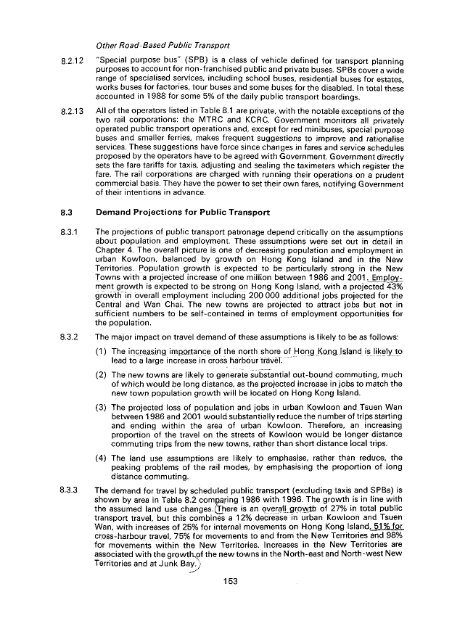Untitled - HKU Libraries - The University of Hong Kong
Untitled - HKU Libraries - The University of Hong Kong
Untitled - HKU Libraries - The University of Hong Kong
- No tags were found...
You also want an ePaper? Increase the reach of your titles
YUMPU automatically turns print PDFs into web optimized ePapers that Google loves.
Other Road-Based Public Transport8.2.12 "Special purpose bus" (SPB) is a class <strong>of</strong> vehicle defined for transport planningpurposes to account for non-franchised public and private buses. SPBs cover a widerange <strong>of</strong> specialised services, including school buses, residential buses for estates,works buses for factories, tour buses and some buses for the disabled. In total theseaccounted in 1 988 for some 5% <strong>of</strong> the daily public transport boardings.8.2.1 3 All <strong>of</strong> the operators listed in Table 8.1 are private, with the notable exceptions <strong>of</strong> thetwo rail corporations: the MTRC and KCRC. Government monitors all privatelyoperated public transport operations and, except for red minibuses, special purposebuses and smaller ferries, makes frequent suggestions to improve and rationaliseservices. <strong>The</strong>se suggestions have force since changes in fares and service schedulesproposed by the operators have to be agreed with Government. Government directlysets the fare tariffs for taxis, adjusting and sealing the taximeters which register thefare. <strong>The</strong> rail corporations are charged with running their operations on a prudentcommercial basis. <strong>The</strong>y have the power to set their own fares, notifying Government<strong>of</strong> their intentions in advance.8.3 Demand Projections for Public Transport8.3.1 <strong>The</strong> projections <strong>of</strong> public transport patronage depend critically on the assumptionsabout population and employment. <strong>The</strong>se assumptions were set out in detail inChapter 4. <strong>The</strong> overall picture is one <strong>of</strong> decreasing population and employment inurban Kowloon, balanced by growth on <strong>Hong</strong> <strong>Kong</strong> Island and in the NewTerritories. Population growth is expected to be particularly strong in the NewTowns with a projected ....... increase <strong>of</strong> one million between 1986 andment growth is expected to be strong on <strong>Hong</strong> <strong>Kong</strong> island, with a projected 43%grpwtfi .......In ..... pverair'eWploYrrient including 200 000, additional jobs projected, for theCentral ........ and Wan Chai. <strong>The</strong> new towns are projected to attract jobs but not insufficient numbers to be self-contained in terms <strong>of</strong> employment opportunities forthe population.8.3.2 <strong>The</strong> major impact on travel demand <strong>of</strong> these assumptions is likely to be as follows:(1) <strong>The</strong> increasing jmp^Qitance, <strong>of</strong> the north shore <strong>of</strong> <strong>Hong</strong> .........K.oiigJMaadjs likely tolead to a large increase in cross harbour 'travel.(2) <strong>The</strong> new towns are likely to generate substantial out-bound commuting, much<strong>of</strong> which would be long distance, as the projected increase in jobs to match thenew town population growth will be located on <strong>Hong</strong> <strong>Kong</strong> Island.(3) <strong>The</strong> projected loss <strong>of</strong> population and jobs in urban Kowloon and Tsuen Wanbetween 1 986 and 2001 would substantially reduce the number <strong>of</strong> trips startingand ending within the area <strong>of</strong> urban Kowloon. <strong>The</strong>refore, an increasingproportion <strong>of</strong> the travel on the streets <strong>of</strong> Kowloon would be longer distancecommuting trips from the new towns, rather than short distance local trips.(4) <strong>The</strong> land use assumptions are likely to emphasise, rather than reduce, thepeaking problems <strong>of</strong> the rail modes, by emphasising the proportion <strong>of</strong> longdistance commuting.8.3.3 <strong>The</strong> demand for travel by scheduled public transport (excluding taxis and SPBs) isshown by area in Table 8.2 comparing 1986 with 1996. <strong>The</strong> growth is in line withthe assumed land use changes. ([here is an overall growth <strong>of</strong> 27% in total publictransport travel, but this combines a 12% decrease in urban Kowloon and TsuenWan, with increases <strong>of</strong> 25% for internal movements on <strong>Hong</strong> <strong>Kong</strong> Island jyjjyiQLcrjoss-harhojjir travel, 75% for movements to and from the New Territories and 98%for movements within the New Territories. Increases in the New Territories areassociated with the growtK<strong>of</strong> the new towns in the North-east and North-west NewTerritories and at Junk Bay. }153
















